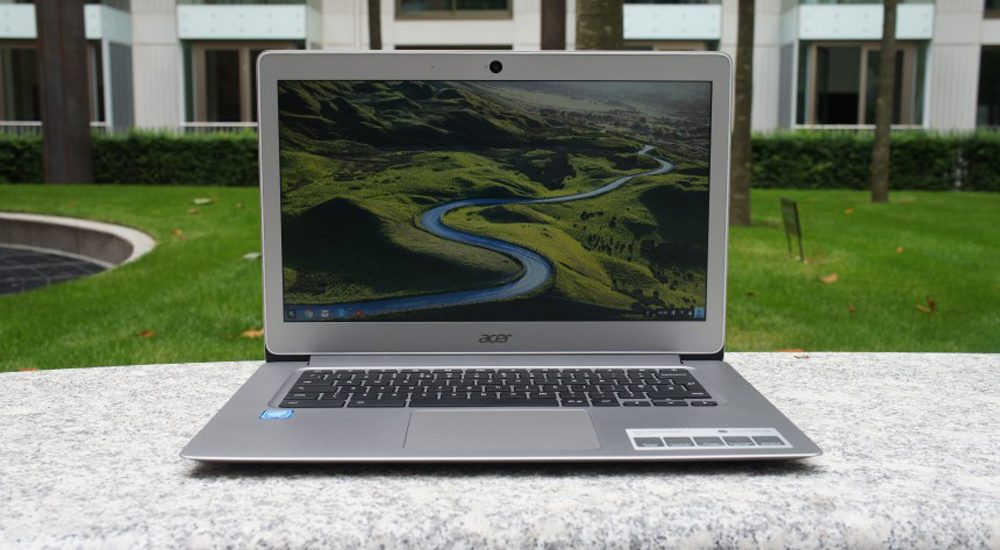Acer’s “MacBook Air” Chromebook is an exquisitely made Chrome OS laptop
Chromebooks are typically small and basic laptops that sacrifice looks for affordability, but Acer’s new Chromebook 14 looks to shake up that trend. In an effort to prove it’s possible to build a cheap laptop without the usual trade-offs, it’s treading an unusual path with its latest Chrome OS portable.
In fact, you could be forgiven for mistaking the Chromebook 14 for a MacBook Air at first glance. The Chromebook 14’s wedged shape and gold or silver aluminium chassis, black plastic hinge at the rear and sunken keyboard are all reminiscent of Apple’s classic laptop; only the brushed finish on the lid and Acer logo give the game away.

Still, the whole thing feels reassuringly expensive and barely flexes a millimetre if you try to twist and bend it. It’s as chunky as a MacBook at 17mm thick, yet isn’t quite as lightweight, with a 1.6kg heft.
There’s only one model available in the UK right now and for £200 you get a 14in 1,366 x 768 resolution display, an Intel Celeron processor and 2GB of RAM. This being a Chromebook, there’s only 16GB of flash storage, so you’ll be reliant on cloud-based storage solutions for most of your files.
If you’re after something a bit speedier, there’ll be a higher spec version launching soon, with a full HD screen, twice the RAM and storage, and a speedier quad-core processor. Acer has remained tight-lipped about pricing for the time being.
Keyboard and touchpad
The Scrabble-tile keys are another aspect of the design that seems to pay homage to the MacBook Air, and the keyboard is also similar in layout. Critically, the keys are all nicely spaced out and large, with decent travel resulting in comfortable typing.

The sizeable touchpad is responsive, too, but since it’s running Chrome OS, there aren’t as many multi-touch gestures to take advantage of when compared with other operating systems.
Display
Sadly, as is the case with most Chromebooks I’ve reviewed, the display isn’t quite up to scratch. It’s a decent size at 14in, but quality-wise it’s a letdown. It’s not particularly sharp at 1,366 x 766, peak brightness is merely acceptable at 213cd/m2, but it’s the contrast ratio of 287:1 that really lets it down.

It’s the same sorry case with colour accuracy, too, with the TN panel displaying only 54% of the sRGB colour gamut. It all leads to a washed-out, dull display, with a clear lack of richness and vibrancy. While this is largely par for the course with entry-level Chromebooks, there have been a few exceptions over the years, such as the Toshiba Chromebook 2 with its impressive full HD IPS display, and Acer’s own Chromebook R11, which has a smaller, far better quality touchscreen.
Performance and battery life
Tear open the basic £200 model and you’ll find a dual-core Intel Celeron N3060 processor clocked to 1.6GHz that Turbo Boosts up to 2.48GHz. Paired with only 2GB of RAM, it’s a little bit behind the pack, but not by much.
A JetStream score of 47.7 isn’t exemplary, with the HP Chromebook 14 scoring a higher 52.9. Surprisingly, though, in the WebGL 3D Cubes test it achieved an average result of 22fps, bringing it roughly in line with Acer’s Chromebook R11, and is double that of the HP. In general use, it felt responsive and reasonably fast for the most part. Just don’t expect it run as fast with multiple Chrome tabs open – the 2GB of RAM will see to that.

The good news is that battery life is excellent. In our video rundown test, it beats the HP’s Chromebook by over an hour, lasting 10hrs 22mins, and it beats many “more serious” laptops along the way. It’s more than enough to get you through a full working day.
Ports, connections and audio
In terms of connectivity, there’s a good selection of ports and sockets. It has two USB 3 ports and an HDMI output for connecting external displays and there’s a 3.5mm headset output for your headphones. Wireless support extends to dual-band 802.11ac wireless and Bluetooth 4.2, too.

On the flipside, there’s no Ethernet port and, perhaps more significantly, no SD card slot, so you’re stuck with the 16GB of onboard storage and whatever allocation you have in the cloud.
The built-in speakers are reasonable, but nothing out of the ordinary. They’re clear, reasonably loud and mostly distortion free (this only kicks in at very high volume levels). But, as with most laptops and tablets, the sound doesn’t have much weight to it or any bass to speak of. If you want that, plug in your headphones.
Conclusion
Acer’s latest stab at the Chromebook game is a bit of a mixed bag. Its metal-clad chassis is excellent, the keyboard is great, and for a sub £200 device, you’re getting superb build quality. The display, however, is a big let-down, as is the lack of SD card slot and limited internal storage allocation.

If you don’t mind something a little smaller, you’d be better off choosing Acer’s Chromebook R11, which has a similar price and has a better quality screen that’s touch sensitive to boot.
Still stuck on what to spend your money on? Check out our sister site’s list of the best Chromebooks you can buy right now or, if you want something Windows-based, browse this list of the best laptops you can buy in 2016.
Sourse: alphr.com




































